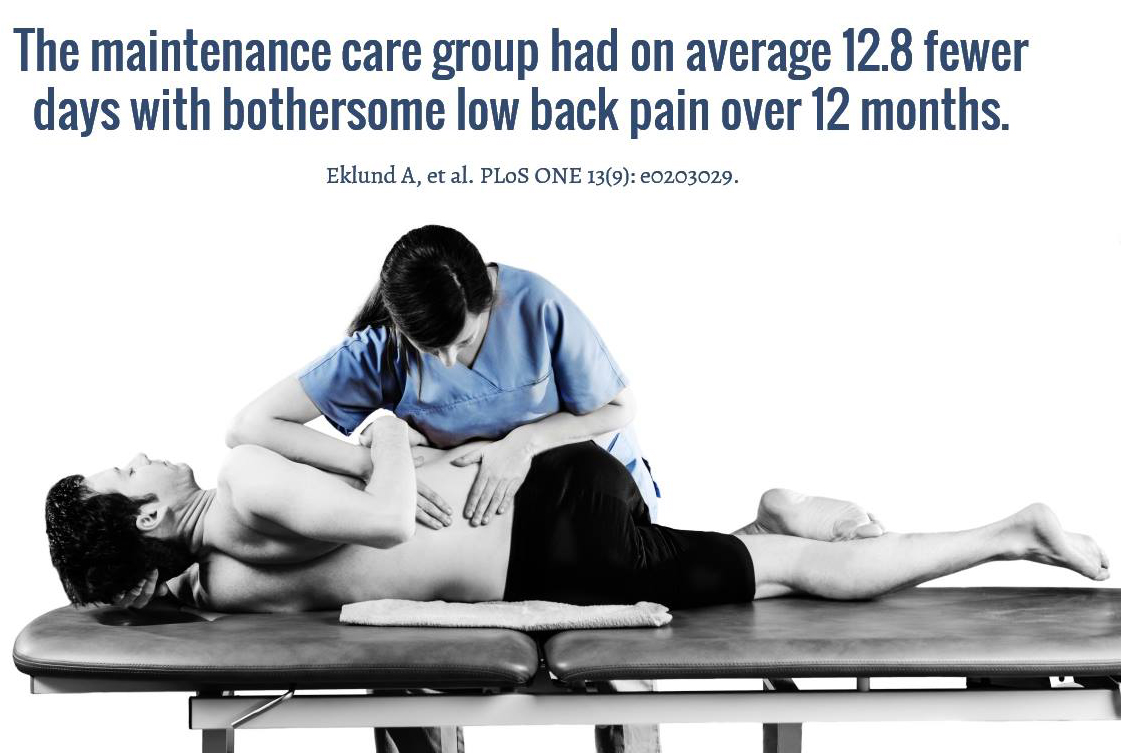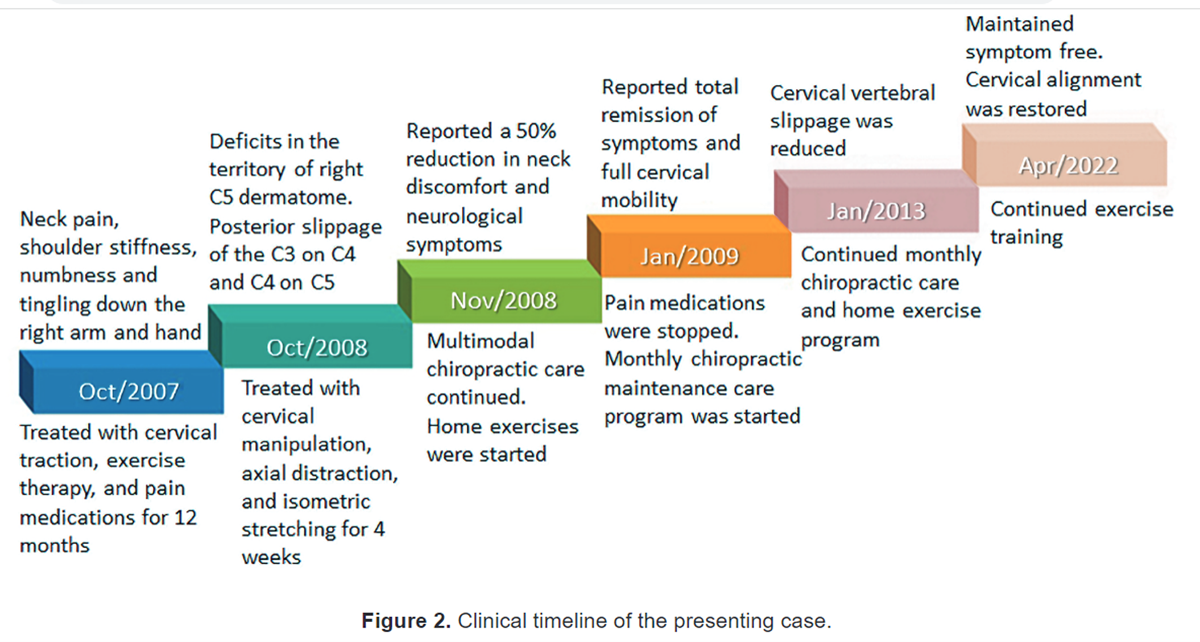The Nordic Maintenance Care Program: Effectiveness of Chiropractic Maintenance Care Versus Symptom-guided Treatment for Recurrent and Persistent Low Back Pain – A Pragmatic Randomized Controlled Trial
SOURCE: PLoS One. 2018 (Sep 12); 13 (9): e0203029
Andreas Eklund, Irene Jensen, Malin Lohela-Karlsson, Jan Hagberg, Charlotte Leboeuf-Yde, Alice Kongsted, Lennart Bodin, Iben Axén
Karolinska Institutet,
Institute of Environmental Medicine,
Unit of Intervention and Implementation Research for Worker Health,
Stockholm, Sweden.
BACKGROUND: For individuals with recurrent or persistent non-specific low back pain (LBP), exercise and exercise combined with education have been shown to be effective in preventing new episodes or in reducing the impact of the condition. Chiropractors have traditionally used Maintenance Care (MC), as secondary and tertiary prevention strategies. The aim of this trial was to investigate the effectiveness of MC on pain trajectories for patients with recurrent or persistent LBP.
METHOD: This pragmatic, investigator-blinded, two arm randomized controlled trial included consecutive patients (18-65 years old) with non-specific LBP, who had an early favorable response to chiropractic care. After an initial course of treatment, eligible subjects were randomized to either MC or control (symptom-guided treatment). The primary outcome was total number of days with bothersome LBP during 52 weeks collected weekly with text-messages (SMS) and estimated by a GEE model.
RESULTS: Three hundred and twenty-eight subjects were randomly allocated to one of the two treatment groups. MC resulted in a reduction in the total number of days per week with bothersome LBP compared with symptom-guided treatment. During the 12 month study period, the MC group (n = 163, 3 dropouts) reported 12.8 (95% CI = 10.1, 15.5; p = <0.001) fewer days in total with bothersome LBP compared to the control group (n = 158, 4 dropouts) and received 1.7 (95% CI = 1.8, 2.1; p = <0.001) more treatments. Numbers presented are means. No serious adverse events were recorded.
There are many more articles like this @ our:
CONCLUSION: In patients with recurrent and persistent LBP who responds well to an initial course of manual therapy, MC resulted in a reduction in number of days with bothersome LBP per week, compared with symptom-guided treatment. In total, the Maintenance Care group had on average 12.8 fewer days with bothersome LBP over 12 months. The effect of the intervention was achieved at the cost of 1.7 additional visits to the chiropractor. For patients with recurrent and persistent LBP who are selected according to evidence-based criteria, MC should be considered as an option for tertiary prevention.
From the FULL TEXT Article
Introduction
Non-specific low back pain (LBP) is one of the most common and costly healthcare problems in society today [1]. The burden of disabling LBP on individuals, families, communities, industries and societies is substantial and is now the leading cause of activity limitation and work absence in the world. [1, 2] In Sweden (2012) 12% of the total cost of musculoskeletal disorders arises from spinal pain (ICD M50-M54). [3] Given that LBP is often recurrent and has a large negative impact on society [4], it seems logical to focus on preventive strategies. In general, interventions aimed at prevention of chronic medical conditions are often described as either secondary or tertiary strategies.
Secondary prevention aims to reduce the impact of a condition (LBP) that has already manifested. This is usually done by encouraging strategies to prevent re-injury such as performing exercises. Tertiary prevention aims to reduce the impact of persistent or chronic LBP. This is usually done by helping people manage long-term, often complex pain conditions in order to improve their quality of life and ability to function.
The multifaceted etiology of LBP (including social, behavioral and psychological factors) implies that this is a complex problem in need of individually tailored interventions that are difficult to test experimentally. [5] To date, the number of LBP secondary or tertiary prevention strategies for which there is empirical evidence are few; there is moderate quality evidence that exercise combined with education reduces the risk of an episode of LBP. [6]
Chiropractors are trained to assess and treat disorders of the musculoskeletal system, of which LBP is the most common. [7, 8] The majority of patients seeking chiropractic care receive some form of manual therapy, of which spinal manipulation and mobilization are the most common, often along with advice on exercise. [7, 9–11] Manual therapy has been shown to be effective for some patients with LBP. [12, 13] The outcome can be predicted by clinical history and demographic variables such as sex, social benefit, severity of pain, duration of continuous pain at first consultation, and additional neck pain. [14, 15] For patients receiving manual therapy, one of the strongest known predictors of a positive outcome is subjective improvement at the fourth visit. These patients, who are “fast responders”, also have a greater chance of a good outcome at three and 12 months. [15]
It is common for chiropractors to recommend “maintenance care (MC)”, i.e. preventive consultations/visits for recurrent and persistent musculoskeletal pain and dysfunction. [16] MC can be viewed as a form of secondary or tertiary prevention and may include manual therapy, individual exercise programs and lifestyle advice delivered in regularly spaced visits over longer periods of time. [9–11, 16–18]
Exactly how MC works is poorly understood but the main hypothesis is that treatment may improve biomechanical and neuromuscular function and address psychosocial issues, thereby reducing the risk of relapse into pain. [19–24] About one fifth of all visits to Scandinavian chiropractors are MC visits and 98% of Swedish. chiropractors use the approach to some extent. [16] MC is traditionally employed as a long term-approach described as: “…a regimen designed to provide for the patient’s continued well-being or for maintaining the optimum state of health while minimizing recurrences of the clinical status” [25] and “…treatment, either scheduled or elective, which occurred after optimum recorded benefit was reached, provided there was no evidence of relapse”. [26] A number of studies in Scandinavia have investigated the indications, frequency and content of MC and there seems to be a common management strategy shared by chiropractors [11, 16–18, 27–33] Although MC is widely used, the evidence of its effectiveness is equivocal. [34, 35]
Read the rest of this Full Text article now!





Leave A Comment